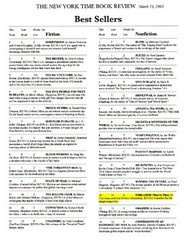Rarely Discussed About Bestsellers
I’ve been in editorial meetings where we sit around and look at current bestseller lists. Leaders will set goals of getting on these bestseller lists. If you are unaware, there are many different versions of bestseller lists for books. Some people focus on the New York Times list while others concentrate on the Christian Booksellers Association lists. Yet others look to publications like USA Today or Publisher’s Weekly (the trade magazine of the publishing industry). I find the details of how the list is compiled are often lost to authors and observers of publishing. How the bestseller list is compiled falls into the same category with how books are sold into bookstores. When you walk into a bookstore to purchase a book, unless you are an author, you don’t often wonder about how the book got there. If you get looking into it, how that book is sold into the bookstore is often a pure mystery. The same mystery surrounds the bestseller list.
For greater understanding of these issues, I recommend the April 3 issue of Publisher’s Weekly and in particular the last page column called Soapbox. Jonathan Merkh, a senior vice president and publisher of Nelson Books and Nelson Business pulls back the curtain on this issue in his article, Jesus and the Bestseller List. Here’s a couple of paragraphs from his article to entice you to read the rest of it, “I study bestseller lists obsessively. Often I find that some Christian books that don't make the general market lists are outselling the books that do by two to one, and sometimes more. In recent years, for instance, our house has had books land among the top 10 of the New York Times hardcover nonfiction lists that were consistently outsold during the same period by other in-house authors such as Max Lucado and John Eldredge—yet neither of these authors ever made the list. The reason? Over half the sales of Lucado's and Eldredge's books were through Christian retailers, whose sales are not reported to Bookscan or counted by the New York Times or USA Today, and are only counted for PW's religion bestseller list.
“If bestseller lists counted sales in Christian bookstores, the list keepers would be surprised to learn how big the religion category really is. When I point this out, I'm told, "We count Christian book sales because we count Ingram, and they own Spring Arbor [a division focused on the Christian market]." Yet Ingram numbers represent only a fraction of Christian market sales for frontlist titles. There's close to, if not more than, $1 billion in retail sales of Christian books unaccounted for by these lists.”
Isn’t it odd? We simply look at the lists—and don’t think about how it is created or how the books are counted—yet those questions are critical to the understanding process and making realistic goals for your own writing life.





















1 Comment:
Terry,
Info like this really helps. Thanks for the input. I appreciate you taking the time to keep us informed!
Post a Comment
That's the writing life...
Back to the home page...